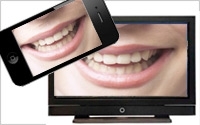
You don't
usually identify Google with starting a fashion trend. But the key fob stick Chromecast device that launched last year has already spawned a competitor in the TV dongle market. One of the most popular
of the streaming media services, Roku, has launched its Roku Streaming Stick. Resembling a Chromecast in size, it too plugs directly into your TV's HDMI port. Roku has had a stick for a while, but it
required a “Roku-Ready” device. The new product follows Google's lead and just works with every TV via WiFi.
But this device is a bit different even from Chromecast in that there seems
to be more functionality on board than the heavily device-dependent Google model. Here you use a packed-in Roku remote control and get the same 1,000-channel selection as you would on the standard
set-top box. Roku seems to be working toward the smartphone throw model, however. You can use the Roku app on iOS and Android to control the interface and channel selection. You can also search
content on the device and toss it to the TV from a select set of apps like NetFlix and YouTube and from their phone-based stored media. An option for casting Web-based content from a laptop or PC to
the TV is coming, the company says.
You get access to a wider range of content than is currently available for Chromecast, but it comes at a steeper $49.99 price point.
All of this
smells like an in-between model that has still not fully transitioned to having the smartphone and tablet interface directly with the TV. You have multiplatform hardware players like Samsung, LG and
Sony either playing in this arena already or clearly positioned to exploit it. But as Sony itself proved long ago, it is tough to get consumers to buy into your entire hardware line just to enjoy some
level of added interactivity. Apple pulls it off a bit with Apple TV. But who is going to make decisions on long-term high-cost items like smartphones and TVs just because they talk to each other?
The dongle technology and casting model all point to what we want and need eventually. The phone is already active when the TV is on. The two screens might as well talk to each
other.
But there is a curious dynamic in the wings here. One of the functions of a smartphone or tablet in prime time is that it gives individuals in the social viewing experience a personal
outlet or window. This phenomenon was first observed years ago in sports viewing when each person in a room could check on whatever other game or stat or player interested them while the group viewed
the shared screen. This personal portal function, I think, is powerful in the living rooms of America. I will be curious to see how it jibes with all smartphones in a room connected to the same
screen. Obviously there is the problem of everyone theoretically having a remote, the living room talisman traditionally passed to the tribal chief. You can do some cool things like dividing
split-screen controls or multiplayer gaming. Some consoles and mobile games are already moving in this direction. Voting and ITV functionality (interacting with ads) could be more feasible in this
personalization of a shared screen.
But this prospect of personal and public screens talking also may tease out a tension between the personal space of the phone screen and the shared space of
a TV. I wonder if there is a psychological wall there we don't know exists. What sorts of device behaviors will we share and keep private?